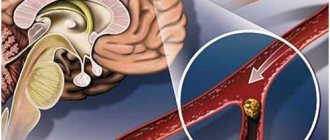Vascular problems occur in most of the population over the age of 40. They lead to disruptions in the functioning of internal organs and systems and can pose a danger to human life. For this reason, it is important to identify them in time in order to begin treatment and stop the development of pathology in the early stages. Clinical signs of vascular disorders differ depending on the location of the damaged vein or artery. Treatment is selected individually: in mild cases, correction of diet and lifestyle is sufficient, in severe cases, surgery may be required.
Why do symptoms of vascular diseases occur?
The total length of all blood vessels in an adult exceeds 95,000 km. Veins, arteries, and capillaries penetrate the body and provide blood inflow and outflow. Initially, the walls of blood vessels are strong and dense, they can easily withstand blood pressure. However, for various reasons, the walls lose their elasticity, lipid deposits form on them, and the person experiences symptoms of vascular disease.
Vascular diseases occur under the influence of such factors: congenital defects, complications after inflammatory processes, intoxication, trauma, metabolic disorders, etc. A common cause of vascular damage is atherosclerosis. It becomes the root cause of many diseases of the cardiovascular system. Atherosclerosis affects the vascular walls and impedes normal blood flow, causing occlusions. Cholesterol plaques weaken vascular tissue, which leads to their dissection and the formation of aneurysms.
Causes
The etiopathogenetic factors of vascular problems are very diverse. The most common causes of vascular pathologies include the following six.
- Physical inactivity and weak physical activity - the myocardium and muscles of the vascular wall without stress sag, weaken, lose shape, lose elasticity and strength. When their tone decreases, blood circulation slows down.
- Poor nutrition - the predominance of unhealthy foods in the diet, as well as excess daily caloric intake leads to obesity and atherosclerosis. The lumen of blood vessels affected by cholesterol gradually narrows, and they cease to function fully. Blood flow slows down and blood clots form. Internal organs do not receive nutrition and oxygen.
- Alcohol abuse is the cause of serious problems with blood vessels and health in general. The breakdown products of alcoholic beverages poison the body and damage blood vessels, causing atrophic processes in their walls. Alcoholics are more likely to form blood clots, which stretch the vascular cavity and reduce their patency.
- Mental tension, stress, outbursts of emotions are very harmful. They create additional stress on the heart, provoking the development of tachycardia and forcing it to transport blood more intensively. Often the vessels do not cope with the task. Clinically, this is manifested by cephalgia, dizziness, paresthesia, and confusion.
- Lack of adequate sleep is a pressing problem. The body does not have enough time to fully recover and rest. The energy wasted during the day is not replenished, which leads to severe vascular dysfunction.
- Hereditary predisposition - the formation of structural or functional vascular disorders in the prenatal period. Connective tissue dysplasia and adrenal insufficiency are inherited. These processes contribute to the development of varicose veins. Systemic lupus erythematosus is an autoimmune disease that provokes a tendency to thrombosis. Vasculitis, endarteritis and many hereditary pathologies are manifested by vascular damage.
Diseases manifested by dysfunction of arteries and veins:
- Atherosclerosis is a metabolic disorder in which low-density cholesterol accumulates on the endothelium of the arteries and forms a plaque, causing vessel occlusion and tissue ischemia;
development of atherosclerosis and artery blockage
- Arterial hypertension is a pathological change in vascular tone associated with a violation of its neurohumoral regulation and leading to arterial spasm;
- Osteochondrosis causes compression of the arteries by overgrown osteophytes and a slowdown in blood flow;
- Vein dysfunction occurs with varicose veins and thrombophlebitis;
- Coronary insufficiency is the cause of systemic circulatory disorders;
- Intoxication due to alcoholism, drug addiction, acute infection, food poisoning;
- ARVI and infectious diseases of the ENT organs - nose, throat, ear;
- Endocrinopathies;
- TBI.
Factors predisposing to circulatory problems include:
- Staying in a stuffy room for a long time,
- Unfavorable working conditions – long periods of standing or sitting, severe physical strain,
- Living in poor environmental conditions with high air pollution leading to hypoxia,
- Very hot or cold climate.
Under the influence of these factors, self-regulation of the walls of blood vessels is disrupted, and they cease to adequately respond to changes in environmental conditions.
Symptoms of heart vascular disease
The cause of insufficient blood supply to the heart muscle is atherosclerosis of the heart vessels. Because of this, myocardial tissue does not receive the required amount of oxygen and important nutrients. Against this unfavorable background, coronary heart disease (CHD) occurs. The main symptoms of hypoxia in coronary artery disease are angina attacks - periodically occurring pain in the heart or sternum, accompanied by shortness of breath and weakness.
The nature of the pain syndrome and its localization are different, that is, the symptoms of angina pectoris are individual. Depending on the functional class of angina, the conditions for the occurrence of an attack differ: if stable angina pectoris manifests itself during physical exertion, then in an unstable form, the condition is dangerous for the development of myocardial infarction and sudden death. Any manifestation of symptoms of angina pectoris is a reason to think about how to check the blood vessels of the heart and protect yourself from complications. The diagnosis is made only by a cardiologist after a series of examinations: ultrasound,
electrocardiography, coronary angiography, laboratory tests.
Principles of treatment
The treatment regimen is selected individually and depends on the specific diagnosis. Most vascular problems can be treated with medications, without the need for surgery. All patients, regardless of the type of vascular disorder, are also given advice on proper nutrition and other aspects of life.
Nutrition and lifestyle
Fatty foods, bad habits, a sedentary lifestyle and excess weight are the main factors that trigger pathological processes in blood vessels. Treatment with medications will not be effective if you do not follow simple rules:
- completely exclude fried and fatty foods, salty foods and sweets in large quantities from the diet;
- give up bad habits: smoking and alcohol;
- pay attention to simple physical activity, including walks in the fresh air;
- normalize sleep and wakefulness - the body needs at least 8 hours of sleep daily;
- avoid stress.
Diet and normal physical activity will allow you to gradually lose excess weight without stressing the body. Extra pounds are also one of the main causes of heart and vascular diseases.
IMPORTANT! Exercises to maintain muscle tone should be discussed with your doctor. Thus, with varicose veins, sports are allowed provided that an elastic bandage or bandage is used. Heart defects are a contraindication to intense exercise, but walking is allowed.
Medicines
Medicines are prescribed individually. Patients often have to take several drugs at the same time, which belong to different pharmacological groups. To normalize blood pressure, medications are needed to control it; for varicose veins, venotonics; for high cholesterol levels, lipid-lowering medications. To monitor their effectiveness, it is necessary to periodically undergo routine examinations and monitor blood counts.
Surgical intervention
Most often, surgical treatment is necessary for thrombosis. The operation is prescribed if there is a risk of a blood clot breaking off or in case of complete blockage of the vessel with the formation of pockets. It is performed by resection of the section of the artery or vein that contains the blood clot. Modern medicine also offers less invasive techniques. They involve installing a shunt to ensure normal blood supply to the tissues.
Treatment of vascular problems is carried out after a complete diagnosis of their condition. It should be understood that the doctor’s recommendations should be followed throughout life. Failure to follow simple rules can lead to exacerbation of the disease, including after successful drug or surgical treatment.
Symptoms of peripheral vascular diseases
When the vessels of the lower extremities are damaged, ailments occur that threaten loss of ability to work. The consequences of some of them, for example, obliterating atherosclerosis of the lower extremities, are gangrene and amputation.
The symptoms of vascular disease of the extremities have their own specifics - we have already written about this here. Signs of disease manifest themselves in the form of pain when walking, heaviness, a feeling of coldness, pale skin, erectile dysfunction in men. A common cause of these signs is atherosclerosis of the arteries of the lower extremities. If you experience one or more of these symptoms, make an appointment with your doctor. This group of diseases negatively affects a person’s quality of life, so at the first warning signs it is recommended to undergo an examination of the blood vessels of the legs. This includes physical examination, duplex ultrasound scanning, contrast or magnetic resonance angiography, and other imaging techniques.
The largest vessel of the circulatory system, the aorta, is susceptible to vascular diseases. Most often, aneurysms and atherosclerosis of the aorta occur in this artery. Symptoms of aortic lesions are varied: since the vessel passes through the chest and abdominal cavity, the patient may experience indigestion, chest and back pain. Most people do not notice the symptoms of the disease at all, so treatment of aortic atherosclerosis begins already at the stage of complications.
Diagnostic procedures
Diagnosis of vascular pathologies is carried out according to a standard scheme, including a conversation with the patient, study of the clinical picture, collection of anamnestic data, general examination and physical examination. These techniques provide only a general idea of the existing pathology. To make an accurate diagnosis and prescribe adequate treatment, the results of laboratory and hardware tests are required.
Comprehensive laboratory and instrumental examination of the patient:
- General clinical and biochemical blood tests - detection of anemia and inflammatory changes,
- Lipidogram - the ratio of lipid complexes in the blood,
- Coagulogram - determination of blood clotting indicators, tendency to thrombosis or bleeding,
- Determination of hormonal status,
- ECG and EchoCG - identifying the structural and functional state of the heart muscle,
- Contrast angiography, cardiac coronography - assessment of the performance of blood vessels, their location, affected areas, developmental anomalies,
- Duplex scanning includes ultrasound and Dopplerography of blood vessels. Ultrasound visualizes veins and arteries, reflecting the anatomy and existing disorders. Doppler determines the speed and intensity of blood flow.
- Tomography – obtaining a three-dimensional, layer-by-layer image in several projections of any vein or artery.
The results of such an examination make it possible to accurately determine the cause of vascular dysfunction and select a treatment regimen for the patient. To avoid various problems with blood vessels, they need to be strengthened, cleaned and hardened.
Symptoms of cerebrovascular diseases
Damage to the arteries supplying blood to the brain leads to no less serious consequences. The consequences of atherosclerosis of the brachiocephalic arteries are brain failure. A dangerous condition is stenosing atherosclerosis, when the lumen of the carotid artery is blocked, leading to a stroke. When the carotid artery is damaged, short-term ischemic attacks sometimes occur. In this case, vascular disease manifests symptoms in the form of speech disturbances, headaches, blurred vision, and numbness in the extremities of one half of the body. Read more about the symptoms of stenosing atherosclerosis at: https://endovascularclinic.ru/atherosclerosis/stenosing.
On the importance of timely diagnosis and prevention
Many ailments go undetected until severe complications occur. The chances of a speedy recovery are increased by timely diagnosis of blood vessels. Any symptoms of vascular diseases of the blood vessels are a reason to contact a specialist as soon as possible.
Prevention of vascular diseases is also very important. It is aimed at maintaining vascular health and preventing further development of diseases. You can get more detailed answers to your questions through a free online consultation with a cardiologist, which is available on our website.
How to avoid complications?
Considering that diseases affecting blood vessels do not occur overnight, but develop over a long period of time, to prevent dangerous consequences, we recommend undergoing a preventive examination. Modern methods of vascular diagnostics will help detect the disease in the early stages of its development. These include computed tomography, ultrasound, coronary angiography, etc.
In the early stages, the development of vascular diseases is stopped with the help of drug therapy and lifestyle correction. However, if these measures are not enough, endovascular interventions come to the rescue. Angioplasty and vascular stenting procedures are not inferior in their effectiveness to open surgical operations, but in comparison with the latter they are painless and do not require long-term rehabilitation. Vascular reconstruction is performed under local anesthesia, and the recovery period takes 1-2 weeks.











